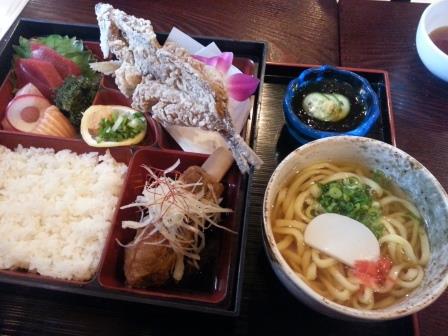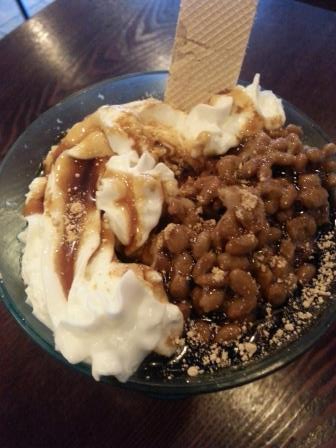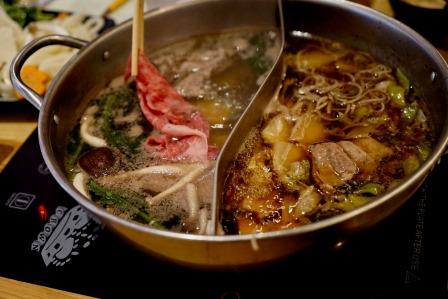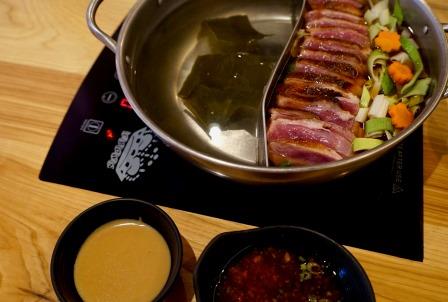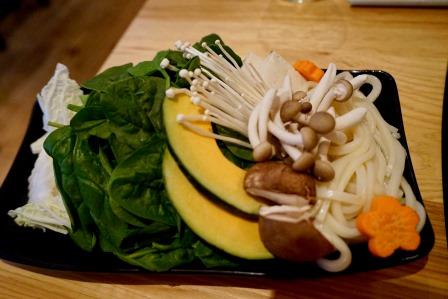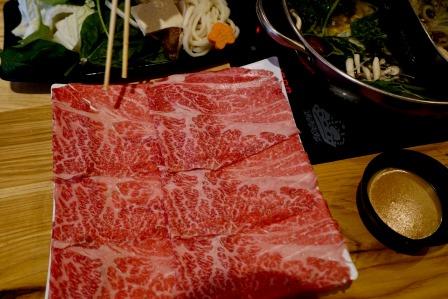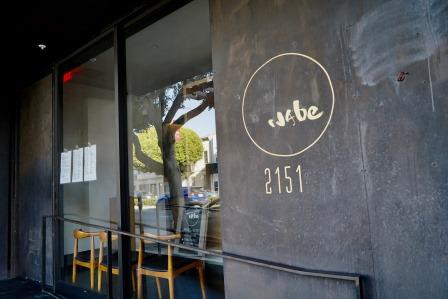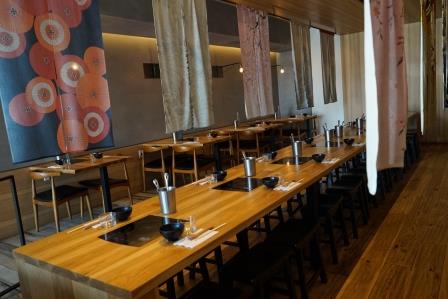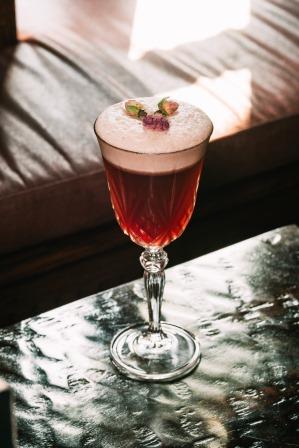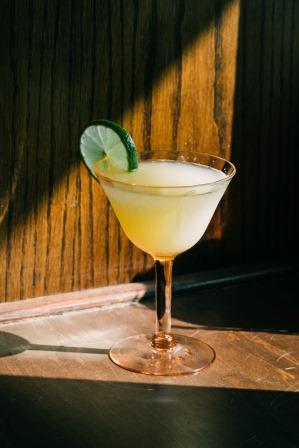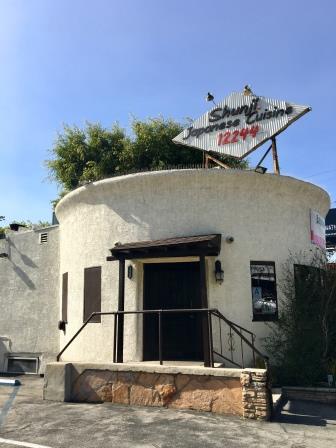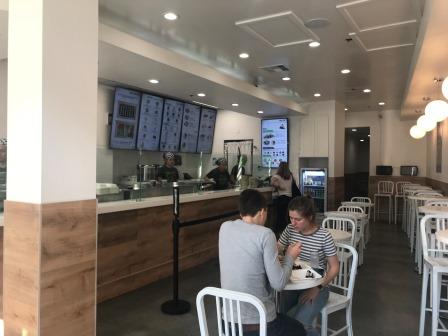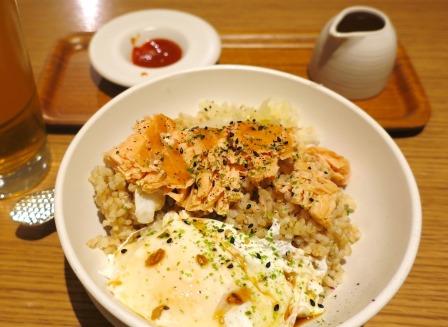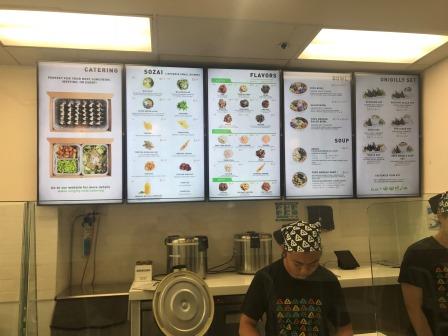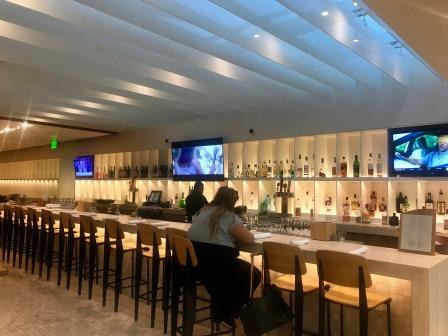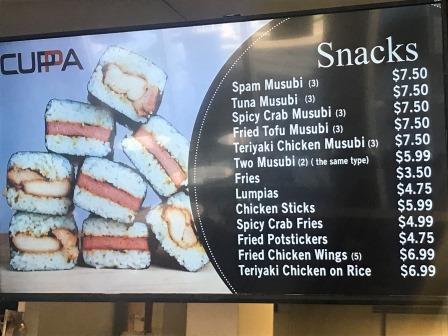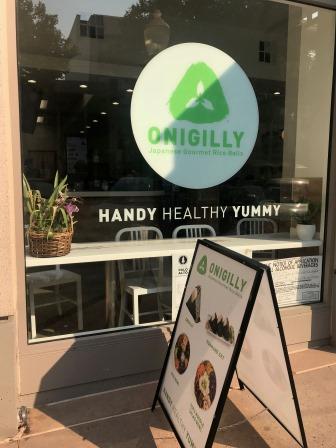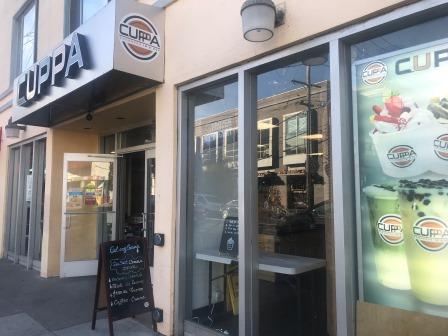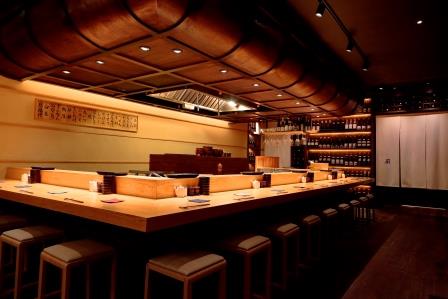
By Keiko Fukuda
An Okinawan restaurant, Habuya Okinawan Dining, was opened in December of 2010 in Tustin. Mere 3 months after the opening, it was featured as “The Best Hidden Japanese Restaurant” in the Los Angeles Times, which gave this restaurant a big boost. Mayumi Burgus from Okinawa, the owner of the restaurant, says, “Back then, people used to form a long line that went over the street corner.” Since then, this place has become a very popular restaurant known to many people, and no longer could be described as a hidden place.
Some of their regular customers I interviewed described the charms of this place as “good ambience” and “authentic Okinawan dishes”, followed by a fantastic comment, “everything they serve here is delicious!” I thought Mayumi was the chef here because she is from Okinawa. But, actually, it is her husband, Hiroki Kimura, who is from Yamagata prefecture, is in charge of cooking. He came to the US after working several years in Japan as a chef, and worked at a Japanese restaurant in Los Angeles. He met Mayumi around the time he was thinking about going back to Japan. She told him about her dream of opening an Okinawan restaurant in the US. Coincidentally, Hiroki grew up listening to his grandmother who used to tell him how his great uncle (the grandmother’s brother) survived during the war thanks to the kindness of Okinawan farmers who hid him from the enemy to protect him so he could go home alive. Hiroki, then, developed a sense of someday returning the favor to the people in Okinawa. He thinks back and believes that his becoming a chef, and meeting Mayumi in the US were meant to happen to connect the two points to form this line of events.
“However, 90% of the people I consulted with said, “Okinawan food is not a common everyday food, and succeeding in running an Okinawan restaurant here is unlikely, but I didn’t give up. I tried different things, which included researching for tastes that would be more easily accepted by people who are not Okinawan natives by using bonito or konbu-based dashi instead of tonkotsu, adding menu items other than Okinawan specialty dishes, etc.,” says Hiroki. The Ryukyu Gozen, which was served on my interview day was the Okinawa version of a gorgeous full course menu. It consisted of “Deep Fried Banana Fish”, “Okinawa Mozuku”, “Okinawa sea grapes and Sashimi”, “Stewed Pork Belly”, and “Okinawa soba”. It reminded me of the true local tastes I experienced in Naha. Especially, sea grapes, which should be very rare in the US, is one of hard-to-get precious ingredients. I heard that they try their best to get as much made-in-Okinawa ingredients as possible.
“Our desire to contribute to Okinawa is very strong. Therefore, we naturally promote Okinawa-made products, not only for the food ingredients, but also for sake brands in our drink menu,” says Hiroki. Mayumi continues, “We are the number one seller of the draft version of Orion beer”. Horoki further adds, “The more Okinawan food ingredients people consume in the US, the more Okinawa gets benefited. However, it won’t be meaningful unless this keeps going. Such flow of movement will die down if we fail our restaurant business and end up closing the restaurant. I realize that it is so important to keep up with the success in this business. This is my way of returning the favor to Okinawa for my family”.
The cooking part is relied on Hiroki’s hands, but servicing and marketing part is the responsibility of Mayumi. She came to the US when she was 21 years old.
She was commuting to the Japanese restaurant she worked for taking an hour and a half by bus. While she worked at the restaurant, she was also busy creating Okinawan-themed arts. She came to the US originally to get married, but later got divorced. She kept hanging on her dream of running an Okinawan restaurant while working hard as a single mother, and that dream became real when she met Hiroki. Mayumi’s talent as an artist is now well reflected upon Habuya’s interior space. Colorful Hand-written menus decorate the walls, and items bought in Okinawa, and brought to the restaurant by regular customers fill the place.
Mayumi says, “For customers who are anime fans often describe that his place makes them feel as if they have wondered into the world of “Spirited Away”. This restaurant, which has been increasing the number of customers with its comfortable ambience and delicious food, has welcomed its 8th anniversary in December of 2018.
和食の技効かせた沖縄料理の店
2010年12月にタスティンにオープンした沖縄料理の店、Habuya Okinawan Dining。その3カ月後にロサンゼルスタイムズに「Best Hidden Japanese Restaurant」として紹介されたことが店の大きな転機となった。沖縄出身のオーナー、真弓バーガスさんが言うには「角を曲がった先まで入店を待つ長蛇の列ができた」そうだ。それからは「Hidden」という修飾語が似つかわしくない、誰もが知る繁盛店へと成長した。
何がこの店の魅力かを周囲の常連客に聞くと「雰囲気がいい」「本格的な沖縄料理が食べられる」に続いて、「何を食べても美味しい」という絶賛のコメントが返ってきた。料理を手がけているのはウチナーンチュの真弓さんかと思いきや、実は山形県出身の夫、木村裕樹さん。裕樹さんは料理人として日本で数年の経験を積んだ後に渡米し、ロサンゼルス近郊の日本料理店に勤めた。帰国を控えた頃、真弓さんと知り合い、彼女から「アメリカで沖縄料理店を開けたい」という夢を聞く。裕樹さんは幼い頃から祖母に、大伯父(祖母の兄)が戦時中、沖縄の農家にかくまわれて無事に復員することができたことを聞かされて育った。「いつか沖縄の人に恩返しをしたい」と思うようになり、料理人になった自分がアメリカの地で真弓さんと出会ったことで「点と点が繋がって線になった」と振り返る。
「しかし、相談した人のうちの90%からは『沖縄料理なんて毎日食べるものではないから、店を開けても成功しない』と言われました。それでも諦めず、豚骨よりもかつおや昆布だしを使うなど沖縄の人以外にも食べやすい味を研究したり、また沖縄料理以外のメニューも揃えたりすることで工夫しました」と裕樹さん。
取材当日にいただいた琉球御膳は、グルクンの唐揚げ、もずくの酢の物、海ぶどうと刺身、ラフテー、さらに沖縄ソバとまるで満漢全席の沖縄バージョンのような豪華さ。那覇で食べた本場の味の記憶がよみがえる。特に海ぶどうはアメリカではほとんど口にできない貴重な食材のはず。これらの食材、同店では可能な限り、沖縄産を仕入れているそうだ。
「沖縄に貢献したいという思いが強いので、料理もそうですが、お酒も当然沖縄のものをプッシュしています」と裕樹さんが話すと、「オリオンビールの生ビールの売り上げはうちが全米ナンバーワンです」と真弓さんが続ける。さらに「沖縄産食材をアメリカで食べてもらえばもらうほど、沖縄にお金が行きます。しかし、これは続けなければ意味がありません。店を潰してしまえば、その流れは途絶えてしまう。だから、店を継続させることが非常に大切だと認識しています。このことは私の家族が沖縄から受けた恩返しです」と裕樹さん。
料理は裕樹さんの腕にかかっているが、接客や広報、マーケティングは真弓さんが担う。21歳で渡米した真弓さんは、最初の勤務先である日本食レストランまでバスで片道1時間半をかけて通った。レストランで働くかたわら、沖縄をテーマにしたアート作品製作にも精を出した。渡米の理由は結婚だったが、その後、離婚。シングルマザーとして奮闘しながら沖縄料理店経営の夢を抱き続け、裕樹さんとの出会いで夢は花開いた。そして、真弓さんのアーティストとしての才能が、今はHabuyaの内装にも反映されている。壁を賑やかな手書きメニューが飾り、常連が沖縄で買って持ち込んだというアイテムが所狭しと配置されている。
「アニメファンのお客さんは『千と千尋の神隠し』の世界に迷い込んだよう、と表現しますね」と真弓さん。その居心地の良さと美味なる料理で顧客を増やし続けた同店は、2018年12月、開店8周年を迎えた。
Habuya Okinawan Dining
14215 Red Hill Ave.,
Tustin, CA 92780
(714)832-3323
Mon.-Fri. 11:30am-2:00pm
5:30pm-11:00pm
Sunday Closed

By Kosuke Kuji
The most important objective of this business trip to Los Angeles was the “30th Japanese Food & Restaurant Expo,” sponsored by Mutual Trading, held at the Pasadena Convention Hall. This business-to-business event, held for the thirtieth time this year, drew 133 food and sake producers, etc., and 2,667 customers in one day, the highest number of exhibitors and attendees in it’s thirty-year history. Nearly seventy-percent of customers are restaurant industry professionals, with twenty-percent of the consumers consisting of Japanese nationals.
These statistics indicate how many non-Japanese professionals and consumers in the U.S. today are working in the Japanese cuisine and sake industry, or consuming Japanese cuisine, indicative of the widespread consumption of Japanese cuisine among non-Japanese consumers. In other words, Japanese cuisine and sake are no longer consumed only by Japanese nationals homesick for their homeland.
Sake producer Nankabijin never received such high customer turnout at their booth as they did this year. Their “Awasake Sparkling,” debut in the U.S. during this expo, was especially popular with many orders received. High-end sparkling Japanese sake is definitely accepted in the U.S. market.
Also, my college classmate from the Tokyo University of Agriculture, currently residing in Los Angeles, attended this expo. It was truly encouraging to receive support in the U.S. from my college classmate.
In the evening, I visited “Chateau Hanare,” the Los Angeles branch restaurant of the Japanese restaurant “Washoku-en,” very popular in New York, along with sake “Houraisen” from Aichi prefecture, and “Tatenokawa” from Yamagata prefecture. I greatly enjoyed the wonderful cuisine prepared by chef Abe, visiting from New York.
The restaurant scene changes quickly in Los Angeles leading California, the most populous state in the U.S., where the market for Japanese cuisine is anticipated to continue growing. We must continue producing even higher quality of sake to bring satisfaction to our U.S. consumers!
P.S. Right after I left, restaurant “Chateau Hanare” welcomed Leonardo DiCaprio as a customer…! Very disappointed to know I missed his visit!
南部美人ロサンゼルスへ その2
今回のロサンゼルス出張の最大の目的でもある共同貿易主催の「第30回レストランエキスポ」がパサディナコンベンションホールで開催されました。今回で30年を迎えたこのアメリカ最大のB to Bイベントは、何と133の食品、お酒などのメーカーが集まり、2667名ものお客様を1日だけで迎えて開催されました。30回の開催で歴代最高の出展者、入場者の数だったそうです。お客様は70%近くがレストラン関係者、お客様全体に占める日本人の割合はたったの20%しかいません。それだけ今のアメリカでは日本人以外が日本食、日本酒をビジネスにしている、食べたい、飲みたいと思っている、ということで、ノンジャパニーズ、アメリカ人への浸透がすさまじい勢いで進んでいるということです。もう日本人が日本を懐かしみながら食べるのが和食や日本酒なのではありません。
南部美人も今年ほどブースにお客さんが来てくれた年は無いくらい忙しかったです。特にこのエキスポにあわせてアメリカデビューを果たした「あわさけスパークリング」。これが大人気で、たくさんの注文をいただきました。アメリカでも確実にスパークリングの日本酒の高価格帯のものが受け入れられています。
さらに、このエキスポには私の東京農業大学時代のロス在住の同級生も来てくれました。本当に農大のつながりがアメリカでも心強く感じます。
夜はNYで大人気のレストラン「和食えん」のロサンゼルス店の「シャトー・ハナレ」に愛知の「蓬莱泉」さんと山形の「楯の川」さんとお邪魔しました。NYから駆けつけている阿部シェフの素晴らしい料理とお酒を楽しみ増した。
どんどん様変わりするロサンゼルス。アメリカ最大の州カリフォルニアをリードして、和食の市場がどんどん伸びていく予感しかありません。私達も今まで以上に高品質なお酒を醸し、アメリカ人の皆さんに喜んでいたけるようにさらに頑張っていきたいと思います!
追伸:シャトー・ハナレさん、私達が帰ったすぐ後にディカプリオがご来店だったそうです・・・。残念、ニアミスでした!

Text: Mayumi Schroede / Photos: Elli Sekine
In the last few years, the development of Japanese restaurants in San Francisco has been very active. “Nabe” has two locations; one in the Sunset District by the Golden Gate Bridge, and the other, in the Marina District’s high-end shopping streets, both of which are San Francisco’s typical tourist spots. Since its opening, this restaurant chain has been featured in many information magazines including The San Francisco Chronicle, Hoodline, and Eater, and has been attracting a lot of attention. The location I based this report on was the Marina location, which is stylish and modern, but has a Japan-like ambience that has been created with a colorful hanging Noren divider, and Japanese sake bottles decorated on the wall like pieces of art.
The family of the owner, Hilwin Wong, is from Hong Kong. She was born and raised in a restaurant industry family—her grandfather has a restaurant in the Tenderloin District, and her father runs a seafood restaurant, hence she naturally became interested in the restaurant business. For the first 3 years after graduating college, she worked for Cathay Pacific Airlines as a flight attendant.
During that time, she visited many Asian countries and ate at many local restaurants, which got her charmed by delicious Japanese cuisine and its presentation skills. She decided to get into the restaurant business, quit the airline job, and opened the first location in the Sunset District in December of 2012 with the co-owner, Kevin. Then, in November of 2016, the second location in the Marina District opened. She is already thinking about the opening of the third location.
With their motto, “simple, but the best and freshest ingredients”, their collective, well-researched menu based on customers’ needs was born under the consultation of Chef Isamu Kanai. The dashi for all 7 kinds of their nabe is made in-house using Japanese kelp konbu and bonito shavings. Furthermore, original soups such as miso and spicy miso add deeper flavors to the nabe dishes. The meat they use is completely free of anti-biotics and growth hormones. The beef is the highest grade A5 beef from Japan’s Miyazaki prefecture, and the kurobuta pork is procured directly from a farm in Idaho. To retain freshness, all the meat blocks are sliced off after receiving orders. Their particularity shows in everything else as well. The vegetables for the nabe are all organic, and tofu is GMO-free.
All the servers have been trained on how to skim off the scum from the soup, when to add dashi, and when to add vegetables or meats in order for the customers to eat everything in the best cooked condition.
Their pots used in the Nabe restaurants are China-originated divided pots, so you can enjoy 2 kinds of nabe at the same time. According to Mr. Won, the top 3 nabe dishes are #1, Kamonanban ($26), #2, Shabu Shabu ($24), and #3, Ishikari Nabe ($26). Mr. Won also said, “In order to satisfy customers’ stomachs, I would like them to enjoy nabe with matching rice and noodles.ˮ They serve sirataki, udon, ramen, etc. with the nabe. He also said, “We value our ‘no waste’ concept, so I would like them to make zousui (gruel) using the leftover soup to enjoy until the last drop of the nabe”.
This time, I tasted the recommended 2 kinds, “Kamonanban (with soba)”, and “Shabu Shabu (with udon)”. The duck meat for the “Kamonanban” is procured from Maple Leaf Farm in Indiana. Slightly-thick slices of the duck meat are soft, and the rich juice flows out into your mouth with every bite. Mr. Won tells the secret. “To utilize the power of the ingredients, nothing extra should be added.
Just marinade the meat with mirin and shoyu dashi.” As for “Shabu Shabu”, the soup soaks into the thin-sliced Miyazaki wagyu well, and you can enjoy vegetables and meat in 2 different ways with 2 kinds of house-made sauce, ponzu, and goma (sesame) miso. After enjoying the nabe fully, you make rich zousui with the leftover flavorful soup, which was produced by the vegetables and meat, to finish up. This will raise your satisfaction level to maximum.
They carry not only many brands of Japanese sake to match the nabe dishes, but also a local draft beer called “Harajuku Girl Yuzu Lager” of a local beer factory, HolyCraft. You cannot find this rare find anywhere else. Its citrus-flavored refreshing taste is very popular. I highly recommend one to try the nabe dishes, which is perfect for the coming season, along with sake.
良質食材にこだわったシンプルな「Nabe」がブレーク中
ここ数年、日本食レストランの展開の勢いが目覚ましいサンフランシスコ市で、代表的な観光地であるゴールデンゲートパーク沿いのサンセット地区と高級ショッピング街のマリーナ地区の2箇所に店舗を構える「Nabe」。開店以来、サンフランシスコ・クロニクル紙やHoodline、Eaterなど多くの情報誌に掲載される今注目のレストランだ。今回取材したマリーナ地区の店舗はお洒落でモダンな作りだが、和風で色彩豊かな暖簾やアートの様に壁に飾られた日本酒のボトルが和の雰囲気を醸し出している。
オーナーのヒルウィン・ウォン氏の一家は香港出身で、祖父がテンダーロイン地区にレストランを、父親もシーフード・レストランを営む飲食業の家系に生まれ育ち自然とレストラン経営に興味を持つようになった。大学卒業後の約3年間はスチュワーデスとしてキャセイパシフィック航空に勤務し、その際にアジア諸国を訪れレストランを食べ歩き日本食の美味しさとプレゼンテーションに惹きつけられたという。その後、レストラン経営を決意しスチュワーデスを退職、共同オーナーのケビン氏と共に2012年12月にサンセット地区に第1店舗をオープンした。その後、2016年11月に第2店舗目となるマリーナ地区店を開店、将来は第3店舗目のオープンも視野に入れている。
「シンプルだが最高で新鮮な食材を」をモットーに、カナイ・イサム氏がコンサルタントシェフを務め、客のニーズに応え研究を重ねた集大成のメニューが誕生した。全7種類ある鍋のダシは全て自家製で真昆布や鰹節を使っており、他にも味噌や辛味噌などのオリジナルスープが鍋を味わい深いものにしている。使用する肉は抗生物質や成長ホルモンを一切使っておらず、牛肉は宮崎県から最高級のグレードA5の宮崎和牛の肉を、黒豚肉はアイダホ州の農家から直接仕入れており、肉は鮮度を保つ為に注文を受けてからスライスされる。鍋に使用する野菜も全てオーガニックで、豆腐はGMOフリーのものを使用する徹底ぶり。サーバー全員が灰汁の取り方やダシ追加の頃合い、野菜や肉を入れるタイミングなどトレーニングを受けており、客が食材を最高の状態で食べれるように配慮されている。
「Nabe」で使用する鍋は中国発祥の仕切り鍋で、2種類の鍋を同時に楽しめるようになっている。ウォン氏によると、鍋の人気トップ3は1位が「鴨南蛮鍋(26ドル)」、2位が「しゃぶしゃぶ(24ドル)」で3位が「石狩鍋(26ドル)」だという。更にウォン氏は「お客様の胃袋を満足させる為、鍋にあった米・麺類をマッチングして楽しんで頂く」と、シラタキやうどん、ラーメンなどを鍋と共に提供している。また「“もったいない”というコンセプトを大事にしており、最後に残ったスープを雑炊にして最後の1滴まで鍋を楽しんで欲しい」と語る。
そこで今回、お勧めの「鴨南蛮鍋(蕎麦付)」と「しゃぶしゃぶ(うどん付)」の2つを賞味させて頂いた。「鴨南蛮」の鴨肉はインディアナ州のメープルリーフ農場から仕入れている。少し厚めにスライスされているが柔らかい鴨肉は噛む度に濃厚な旨味が染み出し、その秘訣は「素材の力を活かし余計な物は一切加えず、味醂や醤油ダシを染み込ませただけ」とウォン氏。「しゃぶしゃぶ」は薄くスライスされた宮崎和牛にスープが良く染み込み、自家製のポン酢とゴマ味噌の2種類のタレで野菜と肉の味わいを2段階に分けて楽しむ事が出来る。鍋を堪能した後は、野菜と肉の旨味が染み込んだスープで作る贅沢な雑炊で満足度が一気に上がる。
鍋に合わせた日本酒も多く取り揃えている他、ドラフトビールでは他店では見かけない地元ビール工場HolyCraft社の「Harajuku Girl Yuzu ラガー」を仕入れており、柑橘系の爽やかな口当たりが好評だ。これから季節にピッタリの鍋料理、お酒も併せて是非お試し頂きたい。
Nabe
(Sunset District)1325 9th Avenue / Tel: (415) 731-2658
(Marina District)2151 Lombard Street / Tel: (415) 447-6199
Website: www.nabesf.com
Email: info@nabesf.com
Mon.-Thu. & Sun. 5:00pm – 10pm
Fri. & Sat. 5:00pm – 10:30pm

By Yuji Matsumoto
While restaurants serve a lot of wine and champagne during the holidays, it’s unfortunately still uncommon to see sake served during the holidays. However, when considering the compatibility with the food served, sake is truly the winner in my opinion. Enjoyed in a wide range of emperatures, hot sake is perfect to warm both the heart and mind. A small change in presentation enhances the enjoyable experience of drinking sake.
First, let’s start with the glass. Let’s put aside the usual small sake glass and use white wine glasses to enhance the luxurious appearance on the dinner table.
Also, let’s use the white wine cooler to keep the sake chilled. For those who prefer sparkling wine like champagne, I highly recommend serving sake in a fruit glass. Also, I recommend trying flavored sake that is commonly enjoyed during the holidays. For those who prefer hot sake, I recommend the sake set with bottles heated with candles, sold in local stores. These sake sets goes great together with western dishware.
I recommend chilled kimoto sake for assorted cheese plates, and sparkling wine with caviar and other appetizers. For those who don’t enjoy much alcohol, I recommend flavored (lyche, apple, and yuzu-flavored) sake.
ホリデーシーズンの日本酒
この時期ワインやシャンペンは多くレストランでも出るようになるが、日本酒となるとややこれらにおされ気味になるのが残念である。
しかし、食との相性を考えると日本酒が勝ると思う。しかも温度帯も広く、寒い時期には燗酒を飲みことにより身体とも暖めてくれるのがうれしい。
ちょっとした演出により、おしゃれに日本酒を飲むことができる。
まずは、グラス。いつもの小さい日本酒グラスではなく白ワインのグラスを使用することにより、食卓に豪華さが増す。また、同じく白ワインクーラーで使うものを併用して日本酒を冷たくキープするのに使用してみる。シャンペンなどの発砲酒が好みならフルートグラスで提供してみると面白い。また、同じくフレイバー酒もこの時期に好まれるのでぜひトライしていただきたい。
燗が好きな方は、市販で買えるロウソクで暖める燗セットをお勧めする。これなら、洋食の食卓にもとてもマッチするのである。
チーズの盛り合わせには、冷やしたキモト系の酒、キャビアなどのアペタイザーにはスパークリング酒。アルコールが苦手な人は、フレイバー(ライチ、リンゴ、柚子)酒をお勧めする。
假期季節的清酒
在這時期,許多餐廳均會出現葡萄酒和香檳;但遺憾當談及清酒時會有一種被前述酒類蓋過其氣勢的感覺。
然而,考慮與料理的配合度時,便會覺得清酒勝於其他酒類。而且清酒的溫度範圍寬廣,在寒冷天氣品嘗熱清酒以溫暖身體,頗感快意。
通過少許心思,便能時尚地品嘗清酒。
首先是酒杯。通過使用白葡萄酒杯而非平時使用的小清酒酒杯,能為餐桌增添奢華感。此外,與前者相同,嘗試併用用於冷卻白葡萄酒的儀器,用以將清酒保冷。若你喜歡香檳等發泡酒,能嘗試使用香檳杯盛載,別有韻味。另外加香酒作為此期寵兒,務必一嘗。
鐘情熱酒的人士,推薦使用市面上的蠟燭用作加熱。與西餐的餐桌極為配襯。
以冷藏生酛清酒配搭各種各樣的奶酪;以氣泡酒配搭魚子醬等前菜。不擅長酒精的人,推薦加香酒(荔枝,蘋果,柚子)。
홀리데이 시즌의 니혼슈
이 시기에는 레스토랑에서 와인이나 샴페인을 많이 소개하곤 하는데, 니혼슈(일본 전통술, 청주류)가 이러한 주류에 다소 밀리는 것 같아 안타깝습니다.
그러나 음식과의 궁합을 생각한다면 니혼슈가 좀 더 나은 것 같습니다. 더군다나 온도를 다양하게 선택할 수 있어서, 추울 때는 간자케(따뜻하게 데운 술)를 마시면 몸을 따뜻하게 해줘서 기분도 좋아집니다.
조금만 연출한다면 더욱 멋지게 니혼슈를 즐길 수 있습니다.
우선, 유리잔을 준비해 봅시다. 평소에 사용하는 작은 술잔이 아니라 화이트 와인잔을 사용하면 식탁에 고급스러움을 더할 수 있습니다. 그리고 화이트 와인용 쿨러로 니혼슈를 차갑게 유지하는데 이용해보면 좋습니다. 샴페인같은 발포주를 좋아한다면 플룻잔에 담아보는 것도 재미있습니다. 그리고 역시 이 시기에 많이 찾으시는 과일맛 주류도 한 번 도전해 보셨으면 합니다. 간자케를 좋아하시는 분들은 양초로 따뜻하게 마실 수 있도록 만들어진 세트 제품을 추천합니다. 이 세트라면 서양식 식탁과도 잘 어울릴 것입니다.
모듬 치즈에는 차가운 기모토계의 주류를, 캐비어 등의 애피타이저에는 스파클링 주류를. 술이 약하신 분들에게는 과일맛 (리치, 사과, 유자) 주류를 추천한다.
�
※這篇文章使用機器翻譯成中文。我們會用作今後參考,如果可以的話,請給我們意見。請聯繫alljapannews@gmail.com)
※이 기사는 기계 번역을 이용하여 한국어로 번역되었습니다. 앞으로 참고하겠사오니 alljapannews@gmail.com으로 연락주시기 바랍니다.
※この記事は機械翻訳を使って中国語に翻訳されています。今後の参考にさせていただきますので、よければご意見ください。alljapannews@gmail.comまでお願いします。
※この記事は機械翻訳を使って韓国語に翻訳されています。今後の参考にさせていただきますので、よければご意見ください。alljapannews@gmail.comまでお願いします。

By Aya Ota
In a street corner of the West Village where old buildings provide a classy ambience, you will find a richly thick wooden door. Once you step in, there is a space which gives you both nostalgic and new feelings at the same time. You feel as if you have gone back to a different era. This is “Bar Moga”, a cocktail bar which has replicated the images of 1920’s Japan.
“Moga” is short for modern girls. In the 1920’s in Japan (from the Taisho era to the early Showa era), brand-new cultures and fashions were being born one after another under the influences of the Western cultures. Young women at that time, who were leading the world of fashion, were called “Moga”. This bar which has replicated a unique and classic, yet also modern worldview of that time has been well received by New Yorkers, and is being visited by a lot of customers every day. The word, “Moga”, also symbolizes a better status for women in society, so many women, and women groups like to visit this bar.
The most popular items in this bar are its original cocktails. Those unique, and full-of-character cocktails contain Japan-made whiskey and shochu brands, and are accentuated by Japanese ingredients such as yuzu, shiso, shichimi, and yuzu-kosho. Those cocktails also have names such as “Naomi”, “Princess Mononoke”, “Kunoichi”, etc., to give Japan-like impacts. Many customers order Japanese whisky and sake brands. As for sake, “Iki na Onna (Tedorigawa Daiginjo)” brand is especially popular. They provide short and effective translations to Japanese sake brands that they carry, and the translation, “Lady Luck”, is extremely well-received.
This place is unique because, although being a drink bar, it also offers a very comprehensive food menu. Its concept is “Yoshoku comfort food”. For Japanese people, the place gives a nostalgic feel, which makes you reminisce of your childhood, and for Americans, it offers a new unknown genre. Takanori Akiyama, Executive Chef of “All Blue” Group which runs the restaurant, and Shintaro Eleazar Okuda, Chef de Cuisine, created many authentic Yoshoku menu items after multiple trials and errors.
The “Omu Rice ($18), their signature dish, is superb. When you slice into its top, soft-cooked egg omelet slowly runs out, and coats the chicken rice underneath. The house-made Demi-glace sauce has been created to offer the same quality and taste of Japan’s long-lasting Yoshoku restaurants. The chicken rice is flavored with the house Demi-Glace sauce with a touch of house ketchup, and the taste is loved by people of all ages. “Moga Mini Rice Burgers ($14)” is so surprisingly authentically made. Cooked rice mixed with potato starch is formed into the shape of buns, and Kobe beef, flavored with sweet and spicy teriyaki sauce is sandwiched between the buns. Shiso accentuates the burger, and gives it a refreshing taste. Sakura-buta pork is used for the katsu on the“Katsu Sando ($16)”, and they are the only restaurant in the East Coast that uses it. The thickly-sliced pork coated with raw panko, and fried slowly, is very tender, and the juice from the meat flows out and fills your mouth when you bite into it. The house miso katsu sauce that is a mixture of 5 different misos including Nagoya Haccho miso, has been cooked for 4 hours, and coats the fried pork katsu which is sandwiched between Japanese sandwich bread slices.
Every food menu item is addictingly delicious, and makes you want to order the same thing over and over again, but also want to try a different dish at the same time, making you suffer from the dilemma.
Some American customers ask whether they serve sushi, but they end up being satisfied once their concept is explained, and taste the food. They originally planned to serve a 70/30 drink/food percentage ratio, but the food menu is so popular, and now accounts for almost 40%.
They pursue the Japan-like service as well. They want every customer to be sitting down, so sometimes, you have to wait outside. It is also nice that the jazz music they play in the restaurant is not loud, so you can talk comfortably.
I bet everybody mysteriously feels nostalgic, and comfortable in this stylish bar. I strongly suggest that you visit this place, and enjoy the non-routine and out-of-ordinary time.
日本の1920年代の世界観を再現…ドリンクだけでなく食事も自慢のバー
『Bar Moga』
古い建物が並び趣あるウェストヴィレッジの街の一角、重厚感ある木の扉を押して足を踏み入れると、懐かしさと新しさを同時に感じるような空間が広がる。まるで違う時代にタイムスリップしたかのようだ。ここは、日本の1920年代をイメージしたカクテルバー『Bar Moga』だ。
“Moga“とはモダンガールの略。日本では、1920年代(大正から昭和時代初期)に西洋文化の影響を受け、新しい文化やファッションが次々に生まれた。当時、その流行の最先端をいく若い女性たちのことを“Moga”と呼んだ。クラシックでもありモダンでもあるこの独特な世界観を再現したバーは、ニューヨーカーたちにも受け入れられ、連日多くの客で賑わっている。“Moga”は、女性の社会進出を象徴する言葉でもあることから、女性客や女性団体の利用も多いという。
同店の一番人気はオリジナル・カクテルだ。日本産ウィスキーや焼酎を取り入れ、柚や紫蘇、七味や柚胡椒など和食材でアクセントを付けた個性あふれる内容だ。ネーミングも『Naomi』『Princess Mononoke』『Kunoichi』など日本らしさを印象づけている。日本産ウィスキーや日本酒を飲む客も多く、特に日本酒は『いきな女(手取川大吟醸)』が好まれる。同店では日本酒銘柄に気の利いた短い英訳を付けているが、「Lady Luck」という英語名が好評なようだ。
同店はバーでありながら、食事メニューが充実しているのが特徴的だ。コンセプトは「日本の洋食」。日本人にとっては子供時代を思い出す懐かしさがあり、米国人客にとっては未知のジャンルだ。同店を運営するレストラングループ『All Blue』で総料理長を務める秋山剛徳氏と、同店の料理長を務める奥田慎太郎エレアザル氏が試行錯誤を重ね、一見カジュアルに見えるが、本格的な洋食メニューの数々を考案した。
シグニチャーの「オムライス」(18ドル)は絶品だ。ナイフを入れると半熟卵がとろりと流れ出し、チキンライスを包み込む。自家製のデミグラスソースは、日本の老舗洋食屋で提供されているような風味を追求した。チキンライスは、自家製デミグラスソースに、さらに自家製ケチャップを加え味付けしてあり、子供から大人まで愛される味だ。「ライスバーガー」(14ドル)はその本格ぶりに驚かされる。炊いたコメに片栗粉を混ぜてバンズ状に成形し、甘辛いテリヤキ風ソースで味付けした神戸牛を挟んでいる。紫蘇がアクセントになり、さっぱりと食べられる。「カツサンド」(16ドル)は、東海岸では唯一同店でしか使っていないというサクラブタを使用。生パン粉をつけてじっくりあげた豚肉は分厚いけれど柔らかく、一口頬張ると肉汁があふれ出る。名古屋の八丁味噌をはじめとする5種類の味噌を合わせて4時間かけて作る自家製の味噌カツソースに絡めて、日本の食パンで挟む。どれも、やみつきになる美味しさで、何度も同じメニューを食べたくなるし、他のメニューも頼んでみたいという葛藤に悩まされる。
米国人客の中には「寿司はないか」と聞く客もいるというが、コンセプトを説明して食べてもらうと、誰もが満足するという。同店は、当初からドリンク70%、フード30%という割合で計画していたが、フードの人気が高く、今では、フードの割合が40%近くなっているということにも納得できる。
サービス面でも日本らしさを追求しており、客には必ず着席してもらうため、時には店の外に客が待つこともある。ジャズの音量も控えめで静かに話すことができるのもうれしい。
不思議に誰もが懐かしさと居心地の良さを感じる、でもお洒落なバー。ぜひ足を運び非日常を味わってはいかがだろうか。
Bar Moga
128 W Houston Street
New York, NY 10012
Tel: 929-399-5853
www.barmoga.com
Sun-Thursday: 5PM-12AM
Fri-Sat: 5PM-2AM

By Keiko Fukuda
On Pico Boulevard in West Los Angeles, near where the 405 and 10 freeways merge, stands “Japanese Cuisine Shunji”. When first completed in 1931, this roundish uniquely- shaped building was a chili bowl specialty restaurant, and before Shunji, it was a barbecue restaurant. Once you step into the building, a stylish brown-toned space opens up. Among the chic interior decorations, a large Japanese antique dresser which stands between the entrance and the sushi bar which dividing the two spaces, particularly attracts your attention.
“It is a vintage dresser from about 120 years ago,” says Shunji Nakao, the owner/chef. Not only does he have excellent taste in choosing furniture, he also designed the interior space by drawing his own image of it to remodel the place to the present style. The space near the ceiling is covered with dozens of articles published in the Los Angeles Times and LA Weekly, in which the restaurant was featured.
The food served here is sushi made with Tsukiji-direct ingredients, and seasonal cuisine in which plentiful seasonal ingredients are used. Shunji shows his particularity, especially in sushi and sashimi. “In the 1980’s, Japanese cuisine in the US was not well-established yet. Raw fish was not well accepted either.
People didn’t know the difference between sashimi and sushi. I used to wonder a lot about what to do to have Americans eat sashimi. I felt that I needed to keep educating customers who don’t know much about sushi, on the fact that sushi is more than salmon, spicy tuna, and Hamachi. Thankfully, many customers now have become able to eat various kinds of fish. Some of our regular customers have traveled to Japan, and visited well-known sushi restaurants,” says Shunji.
One such customer was Johnathan Gold, a food critic who was one of the admirers of Shunji’s sushi, who passed away recently.
Shunji came to live in the US in 1984. He worked at Osho restaurant on Third Street with Nobuyuki Matsuhisa (Nobu) and Tetsuya Nakao, his brother. In 1987, he followed Nobu when Nobu opened Matsuhisa in Beverly Hills. In 1991, he opened Asanebo in Studio City with his brother, and helped it grow into a popular restaurant where people in the entertainment industry gather.
After that, Shunji moved to The Hump in the Santa Monica Airport, and opened his own restaurant in Tokyo, etc. In 2012, in order to further pursue his own style of sushi, he opened Shunji. People come not just from the Los Angeles area, pbut also from San Francisco, and even New York, to taste Shunji’s sushi.
Besides sushi, many visually-beautiful appetizers made with unique ideas are served. Among them, the Agedashi Tomato Tofu with eggplant and shishito pepper topping, and the Uni Wagyu, which is sea urchin rolled in wagyu beef, are very popular. Their 3–dimensional presentations look so wonderful, and deserve to be mentioned separately. They look like gem stones made with carefully selected ingredients.
So far, it sounds like he has been running his business smoothly with no hardship; however, the truth is that there were times when he was unable to use his arms and legs, and could not make sushi due to the pain from a car accident he was involved in. He tried hard to self-rehabilitate for a few years, but suffered a long time from the side-effects of the injuries from the accident. He went to Japan to have surgery, and has now recovered completely. Actually, he got the information about the Japanese doctor from one of his customers.
To end the interview, I asked him about his future prospects for the restaurant. He said, “I think the Japanese cuisine in the US will become more diversified and specialized. We might concentrate more on mainly serving sushi. I also strive every day to serve the kinds of food that could satisfy even our gourmet customers who know the taste of Japan so well, and would go to Japan to enjoy authentic sushi and Japanese cuisine. I would like to continue working with pride being Japanese, and also would like to play a role to serve as a bridge to the next generation.”
築地直送の魚と旬の食材。寿司にこだわる人気店
Shunji.
Text & Photos by Keiko Fukuda
ウエストロサンゼルス、フリーウェイの405号線と10号線が交差するジャンクションからすぐのピコ・ブルバード沿いに立つ「Japanese Cuisine Shunji.」。1931年に完成した当時はチリボウルの専門店、Shunji.の前はバーベキューレストランだったという丸みを帯びたユニークな形の建物の中に足を踏み入れると、そこには茶系を中心に配したシックな空間が広がっていた。中でも目を引くのは入り口と寿司バーの間を仕切るように置かれた日本の古い箪笥。
「約120年前のビンテージの箪笥です」と話すのは、オーナーシェフの中尾俊二さんだ。家具選びにセンスが光るだけでなく、俊二さん自らインテリアのイメージを絵に描いて現在のスタイルに改装したそうだ。天井近くのスペースにはLos Angeles TimesやLA Weeklyに店が紹介された記事が数十点、レイアウトされている。
ここで出されているのは、築地直送のネタで握る寿司と旬の食材を使った季節料理。俊二さんは、特に寿司と刺身にはこだわりを見せる。「1980年代当時、アメリカで日本料理の地位はまだ低く、生魚も敬遠されていました。刺身と寿司の違いについても知らない人がいました。私はどうやったらアメリカ人に刺身を食べてもらえるか、頭をひねったものです。また、寿司について多くを知らないお客さんには教えていかないといけないと思っています。サーモンやスパイシーツナ、ハマチだけではないということです。今では、有難いことに、それ以外のいろいろな魚も食べてもらえるようになりました。常連さんには日本の有名店に寿司を食べに行く方もいます」。先般亡くなった食の評論家、ジョナサン・ゴールドも、俊二さんの寿司に賛辞を贈る一人だった。
俊二さんが渡米したのは1984年。サード・ストリートにあったOshoで松久信幸(ノブ)さん、兄の中尾哲也さんと働き、1987年、ノブさんがビバリーヒルズにMatsuhisaをオープンする際に行動を共にした。1991年には兄と共同でスタジオシティにAsaneboを開店。ここもまたエンターテインメント業界人が通う人気店に成長した。
そして、俊二さんはサンタモニカ空港内のHumpに移り、東京で自身の店を開くなどした後、さらに自分の寿司を追求するために2012年、Shunji.を開いた。店にはロサンゼルス界隈はもちろん、サンフランシスコやニューヨークからも俊二さんの寿司を求めて客は訪れるという。
寿司以外にも、独創的なアイデアで目にも美しいアペタイザーも数多い。中でもナスとシシトウをトッピングした、揚げ出しトマト豆腐、ウニを和牛でロールしたウニ和牛は特に人気。立体的に盛り付けられたプレゼンテーションの素晴らしさは特筆に値する。厳選された食材を使った宝石のような逸品だ。
現在まで特に苦境はなく経営を続けてきたように思われるが、俊二さんが追突事故にあったことで、一時は手足が動かず、身体の痛みから寿司を握ることが叶わなかった時期もあるそうだ。自力で2、3年かけてリハビリに励んだものの、後遺症に悩まれていた。しかし、日本で手術を受けた結果、今では見事に回復した。その日本の医師の情報も、店の顧客から得たものだという。
最後に今後の店としてのビジョンを聞いた。「これから(アメリカの)日本食は細分化、専門化が進んでいくと思います。うちの店も寿司をメインに絞っていくことになるかもしれません。また、美味しいお寿司や和食を食べに日本に行って来るような、日本の味をよく知っている当店のお客様にも、常に満足して頂ける料理をという思いで日々頑張っています。私自身は今後も日本人として胸を張って仕事をしていくと共に、次世代への架け橋としての役割も担っていければと思っています」。
Shunji.
12244 West Pico Blvd.,
Los Angeles, CA 90064
(310)826-4737
http://shunji-ns.com
Tue.-Thu. 12:00pm-2:00pm
6:00pm-10:00pm
Fri. 12:00pm-2:00pm
6:00pm-10:30pm
Sat. 6:00pm-10:30pm
Closed on Sunday & Monday

By Kosuke Kuji
Arriving in Los Angeles, I took in the clear blue sky, dry air, and strong sunlight, a truly California-like weather. Before coming to California, the Japan Airlines lounge was serving Shinpaku by Nanbu Bijin at the sake bar, where I witnessed the lounge filled with many foreign travelers enjoying Japanese sake, which made me feel proud.
Los Angeles is home to the most competitive battleground in the U.S. for Japanese cuisine, where a new Japanese restaurant opened this summer.
Japanese talent management and entertainment company “LDH” managing the Japanese boy band group “EXILE” opened a Japanese restaurant “LDH Kitchen THE ROBATA” in Santa Monica. I visited this restaurant characteristic for serving quality robata-yaki (char-grilled) dishes and various Japanese sake selections for the first time, where video is projected inside the restaurant using projection-mapping technology.
Patrons of this bustling restaurant are local high-end American diners, whom I saw during my visit. Two Nanbu Bijin selections were listed on the menu, which made me feel excited. Also, EXILE is actively promoting sake in the entertainment industry, with performer Kenchi appointed as the Sake Samurai 2018 held in Kyoto (
http://www.sakesamurai.jp/press180827.html). Someday, I look forward to holding a sake event at this restaurant in collaboration with EXILE, to be introduced worldwide!!
南部美人ロサンゼルスへ その1
ロサンゼルスにやってきました。抜けるような青空、乾いた空気、強い日差し、まさにカリフォルニアらしいお天気です。ロスに来る前に、日本航空のラウンジでは今、南部美人の心白がSAKE BARで提供されていますので、拝見してきました。ラウンジも今は外国人が多くて、日本酒もとても飲まれていてうれしかったです。
ロサンゼルスはアメリカの中でも大変な和食激戦区ですが、そんな中この夏新たな和食レストランがオープンしました。日本のアーティスト「エグザイル」をマネージメントする会社「LDH」さんがアメリカでオープンした和食レストラン「LDHキッチンTHE ROBATA」がサンタモニカに出来ました。このお店は私も初めて経験しましたが、店内でプロジェクションマッピングを上映し、上質な炉端焼きと豊富な日本酒が特徴のお店です。ロサンゼルスのハイエンドなアメリカ人がお客様で、私が行った時も大変多くのお客様でにぎわっていました。南部美人も2種類メニューに入れてくれており、大変うれしく思います。またエグザイルと言えば、来週京都で行われるサケサムライ2018年の叙任者にパフォーマーのケンチさんが選ばれるなど、芸能界でも日本酒を応援していただいております。 (
http://www.sakesamurai.jp/press180827.html)
いつの日かこのお店でエグザイルコラボで日本酒のイベントを世界発信できることが楽しみです!!

By Elli Sekine
Data for Japan’s convenience stores say that 6 billion onigiris (rice balls) are sold each year. A major convenience store chain, Seven Eleven, for instance, sells about 4 million onigiris every day. The number of onigiris consumed every day should be enormous if you include sales at supermarkets and bento specialty establishments. A young group of people were making a plan to launch a franchise business in North America with onigiris, a Japanese daily food, in 2007.
I had been to one of their onigiri sampling events back then before this business started. In those days, onigiris were not sold anywhere except in a few Japanese markets. Sushi had already gained overwhelming popularity in the San Francisco area, and onigiris were also considered to be sushi. In other words, people used to think that rice + seaweed = sushi. In those days, most of them thought that it would be too difficult to market onigiris as a product, due to such poor recognition among the people. However, the three entrepreneurs made a passionate presentation at La Cocina, the organization to support immigrant women’s food businesses in San Francisco, despite the gender gap being men, and seized the opportunity to be supported by them. They launched “Onigilly”, operated in outdoor tents for a while, and then opened an independent store. They are on the right track, successfully increasing the number of the establishments, and heading towards a typical success story.
Currently, in San Francisco, the onigiri boom has arrived. In San Francisco, where commodity prices are going up all the time, onigiris are a good value. They are inexpensive, healthy, and delicious. People rush to buy them in large numbers.
The demand for them is expanding, and not just sold at onigiri shops now. They are now also delivered to IT industry lunches as catering, as boxed lunches for meetings, Uber Eats, etc. Unlike sushi, onigiris are easier to handle because they are not raw. The recipes are simple, and anybody can make them. Each piece is completed, so the quantity can be easily calculated by the number of pieces. For busy one-handed eaters of today, onigiris help them save eating time, and health-conscious people look to them as a superfood for gluten-free or vegan diets.
Presently, there are 5 “Onigilly” restaurants. It has been 6 years since the first opening, and the menu has been evolved yearly. They have expanded the variety, and depending on the size of each restaurant, they are offering other things besides onigiris such as rice bowls which you can add toppings of your choice, zousui (rice porridge), a noodle soup, a tofu noodle salad, etc. The onigiri boom has already spread to NY, LA, etc., and onigiri menus are diversified from high-end to fast-food. Zousui and chazuke are appearing on menus as well.
“Samovar”, a health-conscious restaurant + café in San Francisco, which took the world by storm 10 years ago, opened another restaurant at SFO (San Francisco Airport), which is known as the most gourmet airport, last year.
There are currently 5 “Samovar”s in the Bay Area, and each of them offers slightly different designs and menus. Their SFO location is run by a different team of people than its founders. The “Operator Tastes on the Fly” has invested an enormous capital of $4.1 billion to run the SFO location. They operate as a tea café of San Francisco, at New York, Denver airports, and neighboring high-end hotels, where other local popular restaurants have been selected also.
“Samovar Tea Lounge SFO” ‘s sophisticated exterior and interior are extraordinary. A high-class tea bar, a full bar, and a dining space are set up, and all the menu items are healthy. You can enjoy your meal in a big oasis-like space in the airport. Its rice menu contains smoked duck porridge ($14.5), hojicha ochazuke ($14.50), and salmon egg bowl ($14.50), and you can also add a half-boiled egg or a soup on the side. It is a precious airport gourmet place where you can have a comforting meal before your departure, or upon your arrival.
Mr. Koji Kanematsu, the founder of “Onigilly” has said at the first year, “I want to aim for an onigiri chain that will expand to 500 locations nationwide.” People who were there were laughing at him behind his back then, but this big dream of his does not seem impossible now. The “Onigilly” chain is surely increasing the number of its restaurants, and onigiris are appearing more and more on the menus of many restaurants and fast-food establishments. Nobody calls onigiris sushi anymore. It does not seem long before this dream of the team of Japanese entrepreneurs who have been running towards it the last 10 years, will be realized.
サンフランシスコ・ベイエリアにおにぎりブーム到来!
日本のコンビニエンスストアではオニギリは年間60 億個売れているというデータがある。大手コンビニのセブンイレブンをとっても1 日に約400 万個という消費量だ。これにスーパーやお弁当屋などを入れると驚異的な数字になるだろう。
そんな日本の日常食、おにぎりのチェーン店を北米で展開しようと若いグループが2007 年に起業を構想していた。筆者は当時起業する前のおにぎり試食会に出かけている。当時、寿司が圧倒的な人気を得ていたサンフランシスコでは出回っていなかった。寿司が圧倒的な人気を得ていたサンフランシスコでは、おにぎりも寿司と呼ばれていた。要するにご飯+海苔=寿司という認識だった。
そんな中、おにぎりを商品化するのは厳しいのではないかという意見がほとんどだった。しかし3 人の起業家たちは、サンフランシスコで移民女性達のフードビジネスを支援するLa Cocina で男性でありながら、熱いプレゼンをし、ビジネス支援のチャンスを掴みとった。その後「Onigilly」を起業、テント販売を経て独立店舗をオープン、店舗数を増やすといったサクセスストーリーのレールに乗っている。
今、サンフランシスコでおにぎりブームが到来している。物価が高騰するサンフランシスコで、おにぎりの価値は、安くて健康的、しかも美味しいという理由で消費者が急増している。おにぎりカフェ(店頭)だけではなく、需要が広がっているのは、IT企業へのランチケータリング、そして会議のお弁当、ウーバーイートなどのデリバリーなど。おにぎりは寿司と違い、生では無いので扱いやすい、シンプルなレシピで誰でも扱える。
また、ひとつづつ完結しているので、量はその個数で計算される。何と言っても忙しい「ワンハンド」イーターにとっては食事の時短ができ、健康志向者にとってはグルテンフリー、ベーガンダイエットにも適用されるスーパーフードとしても着目されている。
現在、「Onigilly」は、ベイエリアに5店舗を構える。最初の店舗オープンから6 年経ち、メニューも年々進化している。最近ではオニギリに加えて、好きなものをトッピングに加えていくライスボール(Rice Bowl)、雑炊、ヌードルスープ、豆腐ヌードルサラダなど、店舗の広さによりメニューは異なるが、バラエティーに富んだ内容だ。おにぎりブームはすでにNY、LAなどにも広がり、おにぎりメニューは日本食レストラン以外のハイエンドからファーストフードまで多様化し、メニューも雑炊(粥)や茶漬けなどがメニューに登場し始めている。
サンフランシスコのティーカフェで10 年前に一世風靡したヘルシー系レストラン+カフェの「Samovar」は去年、全米で最もグルメなエアポートと言われるSFO(サンフランシスコ空港)にオープンした。「Samovar」は現在ベイエリアに5店舗を構えるが、店舗によりデザインやメニューが多少異なる。SFO店は創業者とは別チームで、Operator Tastes on the Fly が$4.1 ビリオンという巨額資金を投じてオペレーションを行い、サンフランシスコからニューヨーク、デンバー空港、隣接するハイエンドホテルのティーカフェとして参入する。いずれも地元の人気店が選ばれている。
「Samovar Tea Lounge SFO」は、洗練された外観、インテリアは異彩を放っている。高級なティーバー、フルバー、ダイニングが設置され、食事メニューは全て健康食。空港のオアシスとも言うべき広々としたスペースでは落ち着いて食事ができる。ご飯メニューには、スモークダック($14.50)のお粥、焙じ茶のお茶漬け($14.50)、サーモンエッグボウル($14.50)がベースで、オプションで半熟卵やスープをサイドでつけることもできる。出国、帰国の際に癒しの食事ができる貴重なエアポートグルメだ。
「Onigilly」の創業者、金松こうじ氏は起業元年に「全米500 店舗を展開するおにぎりチェーン店を目指したい」と語った。同席していたものは鼻で笑っていたが、その夢は満更でもない。「Onigilly」は確実に店舗数を増やし、オニギリメニューは多くのレストランからファーストフード店まで拡散している。今やオニギリを寿司と呼ぶ人はいなくなった。
カート一つから夢を実現させようとこの10 年走り続けた日本人起業家達の夢が叶う日もそう遠くなさそうだ。
Onigilly (Newly opend)
164 University Ave.
Palo Alto, CA 94301
(650) 313-2104
http://www.onigilly.com/
Mon.-Sun. 11:00am-9:00pm
Samovar Tea Lounge(Newly opend)
International Terminal A
San Francisco
(650) 821-8949
https://www.samovartea.com
7:00am-8:00 pm

By Yuji Matsumoto
Japanese sake is still a largely unfamiliar beverage to American consumers.
Ninety percent of sake is consumed in restaurants, indicating the unfortunate reality that sake is still far from being casually enjoyed in private homes and parties.
One of the reasons is because the true flavors of sake and how they’re enjoyed is not widely introduced. Therefore, to American diners, sake is still a unique beverage to be enjoyed at local sushi bars. Also, because the prices can be at times higher, products may not be lined visibly on store shelves and information may be lacking on labels, which may be contributing to this issue.
In this issue, I will give you a simple overview of how to select sake.
First, it’s important to decide what menu selections to enjoy the sake with. Similar to how wine enhances the foods you eat, sake is also to be enjoyed during meals.
Meat dishes: Junmai or Junmai Kimoto is recommended (from Kyushu, Tohoku, Kanto, Hokuriku or Nada regions)
Chicken dishes: Ginjo class (from Hiroshima, Niigata, Nada, Hokuriku, and Kanto regions) is recommended
Fish dishes: Ginjo and Daiginjo class (Niigata, Hiroshima, Shikoku, Kyoto regions) are recommended.
Of course, flavoring and preparation methods will influence your choice of sake, but first, it would be interesting to sample sake by region.
日本酒をもっと気軽に
日本酒は、まだまだアメリカ人にとって馴染みの薄い飲み物である。
日本酒の消費の9割はレストランであり、まだまだ家庭やホームパーティーで気軽に楽しむ飲み物には、残念ながらなっていない。
その理由の一つに、まだまだその本当の味や飲み方が紹介されていないため、日本酒(サキ)はアメリカ人にとってスシバーに行った時に飲む特殊な飲料の位置づけがあるためであろう。また、価格も高く、マーケットでの商品陳列方法やラベル情報が乏しいのもその原因であろう。
さて、今回は大雑把ではあるが、日本酒の簡単な選択方法をお教えしよう。
まず、合わせたい料理は何かを決めることが重要。日本酒は、ワインと同じく料理を引き立てる食中酒だと理解していただきたい。
牛肉料理:純米や純米生もと造り(九州、東北、関東、北陸、灘産)がお勧め。
鶏肉料理:吟醸クラス(広島、新潟、灘、北陸、関東産)がお勧め。
魚料理:吟醸クラス、大吟醸クラス(新潟、広島、四国、京都産)がお勧め。
もちろん、味付け、調理方法によって合わせる酒は異なってくるが、とりあえずは、産地によって試してみるのは面白いのでは。
※這篇文章使用機器翻譯成中文。我們會用作今後參考,如果可以的話,請給我們意見。請聯繫alljapannews@gmail.com)←*これは機械翻訳されている旨の但し書きで中国語訳文の上にお願いいたします。
更隨意飲日本酒
日本酒是對美國人來說還是不太熟悉的飲料。
日本酒的消費9成是餐廳,很遺憾地還未成為在家庭和家庭派對中輕松享受的飲料。
其中原因之一是,真正的味道和飲用方法還沒有受到介紹,所以日本酒(sake)對美國人來說,大概定位是在去壽司店時喝的特殊飲料。另外,價格也很高,市場上商品陳列方法和標籤信息缺乏也是原因之一。
那麽,這次雖然很籠統,但我要告訴你日本酒的簡單選擇方法。
首先,重要的是要決定想搭配的菜式。請理解日本酒是和葡萄酒一樣,可以襯托菜式的食中酒。
牛肉料理:推薦純米、純米生酛製造(九州、東北、關東、北陸、灘產)。
鷄肉料理:推薦吟釀等級(廣島、新瀉、灘、北陸、關東產)。
魚類料理:吟釀等級、大吟釀等級(新瀉、廣島、四國、京都產)值得推薦。
當然,根據調味、烹飪方法的不同,相配的酒也會不同,但是首先試著按產地嘗試一下比較有趣。

By Aya Ota
Only after a year since they opened “MIFUNE New York” and “sushi AMANE” at the same time in the Midtown East area, Tokyo Restaurants Factory Inc. opened Toriko NY, the third Yakitori specialty restaurant, in the West Village District in late August of 2018, and is attracting a lot of attention.
“I already anticipate a huge potential,” says Hiroyuki Morishima, General Manager of the Overseas Business Division of the company. The “Toriko” is a successful business model among the high-end Japanese restaurant chains in Japan developed by Tokyo Restaurants Factory Inc. Its concept, “to enjoy Yakitori, which used to be inexpensive casual food culture, in a stylish and sophisticated ambience with wine”, caught on. Since the opening of its first restaurant in 2011, this chain has been growing steadily, and there are 15 of them in Tokyo and Osaka combined. They were sure that this “Toriko” concept would be well received in the dining scene of New York as well from the very beginning of the company’s plan to go to New York, and had been working on its realization. In the preparation of its opening, the experience and knowledge with the opening of “MIFUNE” somewhat helped them in terms of construction, certificates application, hiring etc., but they still experienced many difficulties in developing a completely different type of business model in a completely different geographical condition. As part of their marketing efforts, they started early by hiring a PR company in order to collect customers, so many people visit by seeing the media advertisement; however, the presence and the ambience of the restaurants are also attracting people’s eyes, and drawing neighboring people to the restaurant as well. By word of mouth, they already started gathering regular customers.
“The chicken meat we get here is totally different from what we get in Japan, so we repeated trial and error a lot for the whole processes of preparations, grilling, and spices in order to achieve Japan quality,” says Shinji Odahara, the Culinary Director. He is the executive chef, who manages the whole group, and was called in for the opening of this New York location. He tried so many different kinds of chicken meat, checking the quality by touching and cooking, and settled with the “Bobo Chickens” which are raised freely out of cages in the northern New York State. One selling point of the restaurant is serving of rare parts such as Seseri-Neck, Yagen-Soft Bone, and Bonjiri-Tail, and each part is prepared and grilled with matching delicacy and particularity to complete. By utilizing multiple different sauces and salts exquisitely, best possible tastes are being brought out.
Presently, they offer only 2 menu items for the dining room, “Omakase Course” ($85), and “Toriko Course” ($72). The Omakase Course starts with the “Seasonal Amuse Bouche, 4 kinds”, and followed by the “Chicken-Bone Soup”, and the “Foie Gras Chawanmushi”. After cleaning your pellet with the “House-made Rice Bran Pickled Vegetable/Grated Daikon”, the main Yakitori dish finally comes with 5 chicken skewers, 2 vegetable skewers, tsukune, and wagyu”. To end the course, you get either rice or noodle dish: shio ramen or oyako don. A dessert is also served in this gorgeous course. At the bar, you can order a-la-carte menu items. In order to accommodate some Americans’ requests, they have gluten-free sauce and a vegan menu. They also handle customers who do not care for internal organ parts flexibly. At the Toriko restaurants in Japan, majority of people enjoy Yakitori with wine, but here, at the New York location, the ratio of wine and sake sales is half and half.
“I am certain that Yakitori will be as well accepted as sushi in the US,” says Morishima. “To create fans of Japan” is a mission of Tokyo Restaurants Factory Inc. It may not be too long before you see “Toriko” all over the US.
焼き鳥を世界へ広め、日本のファンを作りたい
ミッドタウン・イーストに『MIFUNE New York』『sushi AMANE』を同時開店してからわずか1年―。東京レストランツファクトリー株式会社が、3店舗目となる焼き鳥専門店『鳥幸ニューヨーク』を2018年8月末、ウェストヴィレッジ地区に開店し、注目が集まっている。
「早くも大きな手応えを感じている」と語るのは、同社海外事業部責任者を務める森嶋博之氏。『鳥幸』は、東京レストランツファクトリーが日本国内で展開する高級和食店の中で成功している業態で、“かつては大衆的な食文化だった焼き鳥を、お洒落な雰囲気でワインと共に楽しむ”というコンセプトがヒットした。
2011年に1店舗目を開店以来、着実に店舗を増やし、現在は東京と大阪で15 店舗展開している。同社がニューヨーク進出を検討していた当初から、『鳥幸』はニューヨークのダイニング・シーンに受け入れられるという確信があり、計画を進めてきたという。開店準備に当たっては、工事、許認可申請、人材採用などの面では、『MIFUNE』での経験や知見に助けられたこともあったが、やはり、全く異なる立地条件で全く異なる業態の展開には苦労も多かったという。集客・マーケティングは、PR会社に依頼して早い段階からメディアに掲載されたことで、メディアを見て来る客が多いが、店の存在や雰囲気自体も人目を引き、近所に住む客も多く訪れる。すでに人が人を呼び、早くも常連客が着いてきたそうだ。
「鶏肉自体が全く異なるので、日本と同じクオリティに仕上げるまで、仕込み、焼き方、調味に至るまで、全ての行程で試行錯誤を繰り返した」と語るのは総料理長を務める尾田原真二。尾田原氏は同社グループ全体を統括する総料理長で『鳥幸ニューヨーク』開店のために呼び寄せた。数多くの鶏肉を仕入れ、すべて手で触って肉質を確かめ試作を繰り返し、ニューヨーク州北部で放し飼いで飼育されているボーボーチキンを採用した。同店では、せせり、やげん、ぼんじりといった稀少部位を味わえるのも魅力のひとつだが、仕込みから焼き方まで、それぞれの部位に合わせた繊細なこだわりで創り上げる。複数のタレと塩を絶妙に使い分け、美味しさを存分に引き出している。
メニューは、現在ダイニングルームでは「おまかせコース」($85)と「鳥幸コース」($72)のみ。
のみ。おまかせコースは、まずは季節の前菜4点盛りに始まり、白湯スープ、フォアグラ茶碗蒸しと続く。ぬか漬け・大根おろしで、口直しをした後に、いよいよメインの焼き鳥(鶏串5本、野菜串2本、つくね、和牛)へ。最後は、鳥幸塩ラーメンまたは親子丼でしめ、さらには甘味も登場するという、なんとも贅沢な内容だ。バー・スペースでは、アラカルトでも注文することができる。米国人客のリクエストに合わせ、グルテンフリーのタレやヴィーガン・メニューも用意。中には内臓が苦手な客もいるため、柔軟に対応している。日本の『鳥幸』ではワインと合わせて楽しむ客が多いが、ニューヨーク店ではワインと日本酒は約半々の売上だ。
「アメリカで焼き鳥は寿司と同じくらい受け入れられると確信している」と森嶋氏。「日本のファンを作りたい」というミッションを掲げる東京レストランツファクトリー。『鳥幸』が全米各地で見られる日もそう遠くないかもしれない。
Toriko
76 Carmine Street
New York, NY 10014
Tel: 646-596-8198
Dinner : Mon – Sat 5:00pm – 11:30pm
(Last Order 10:30pm)
- If you are a bloguru member, please login.
Login
- If you are not a bloguru member, you may request a free account here:
Request Account







